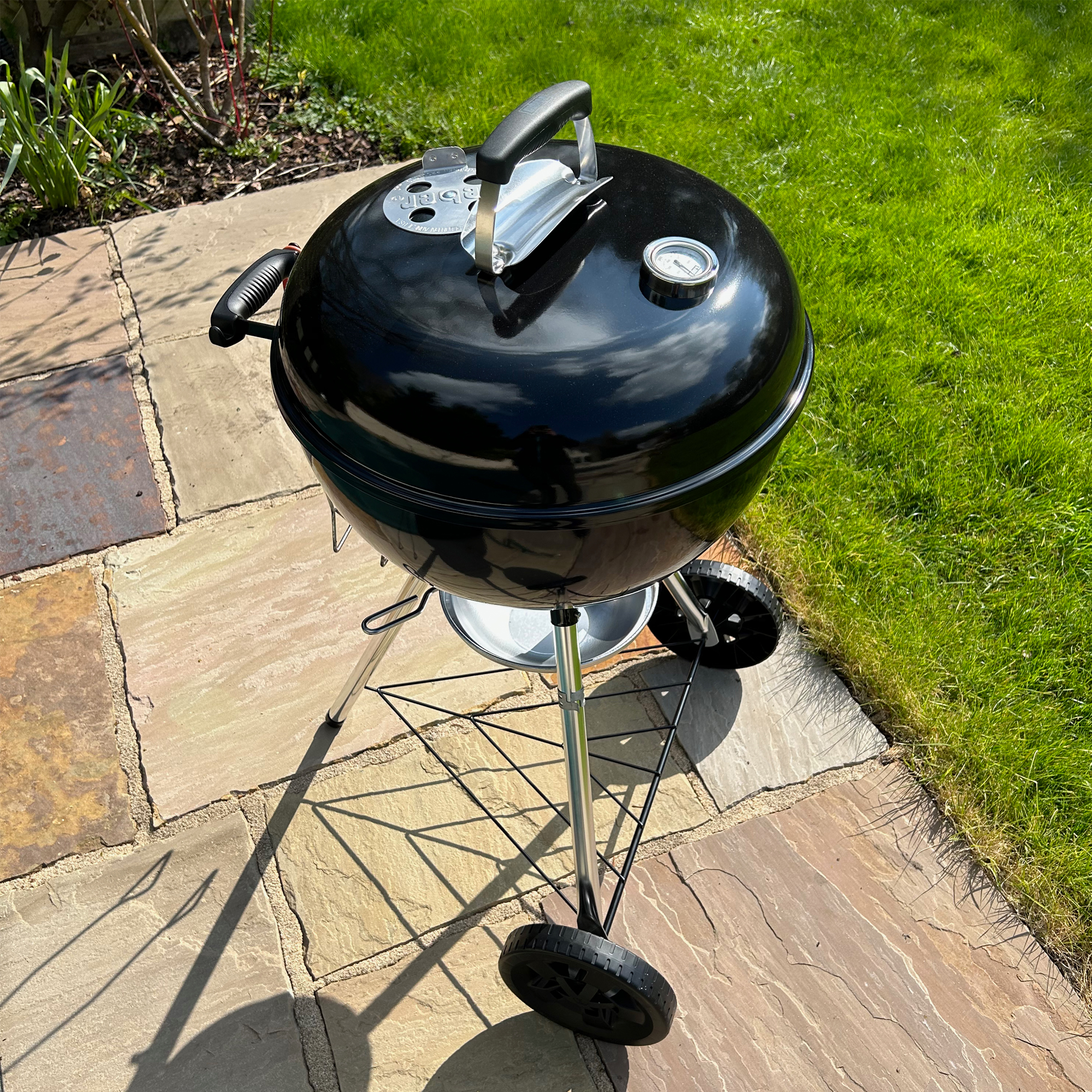
Weber is a barbecue brand that needs no introduction when it comes to the best BBQs. This American barbecue manufacturer has been around for decades and Weber’s founder invented the kettle-style barbecue that’s such a familiar sight in gardens across the UK.
Admittedly at £215, this barbecue is a tad pricier than the copycat versions that you might see around. But as with anything, the cheaper copies don’t always stand up to the real deal. And since we get such a short barbecue season, it’s worth enjoying it and honing those barbecue skills on a quality barbecue that’s designed to work well, rather than one that’s simply designed to be cheap. Though it must be said that you can spend well in excess of £1500 on a barbecue so in the grand scheme of things, this one starts to look pretty affordable.
I tried out this barbecue in spring, so had to dodge the rain and wait for sunny days to be able to give it a thorough review. It’s the ideal size for our two person household, and maybe a couple of guests, but it won’t suit big gatherings. I like it though, it’s a good charcoal barbecue that does its job well.
Weber Original Kettle E4710 specs

- Fuel type: Charcoal
- Materials: Porcelain enamelled lid and bowl, plated steel cooking grate
- Dimensions: 57 x 60 x 97cm
- Cooking area dimensions: 47 cm diameter
- Weight: 13kg
Who tested this BBQ?
Unboxing the Weber Original Kettle E4710, setting up and first impressions
First impressions were good when I opened the box, it’s protected by cardboard inserts, with not a hint of polystyrene to be found. Unboxing and assembly takes around 30-40 minutes, which in comparison to some other barbecues is fairly speedy.
A special tool is provided to assist with bolting the handle to the lid, and the thermometer is easy to attach by hand. The legs and wheels have been cleverly designed with clips that lock it all into position. You only need a screwdriver for the main handle on the side.
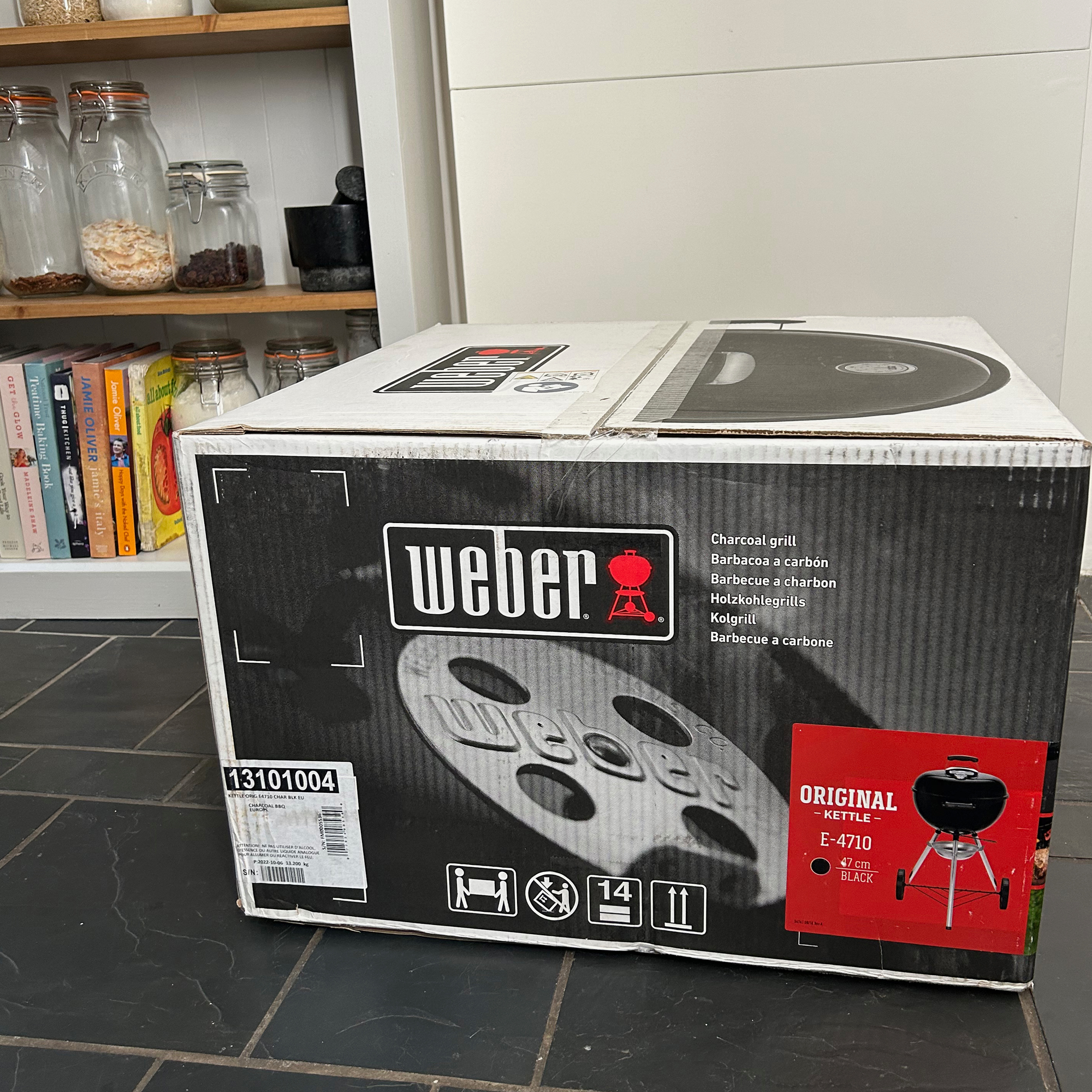
It’s slightly fiddly and has to be assembled in a particular order, but if I can do it in 30 minutes, then most people should be able to tackle it with ease. There are a couple of other things in the box, one is a big plastic bowl that I really wasn’t sure what it was for. But I later found out that it’s a scoop for scooping charcoal out of the bag.
The other accessories are two metal rails that clip onto the cooking grid and a foil drip tin. These are for indirect cooking and the manual gives plenty of advice on how to use them. In fact I was pretty impressed with the manual in general. It contains helpful guides on cooking times as well as suggested amounts of charcoal, lighting the barbecue and other hints and tips. Plus, there’s plenty more useful advice on the website.
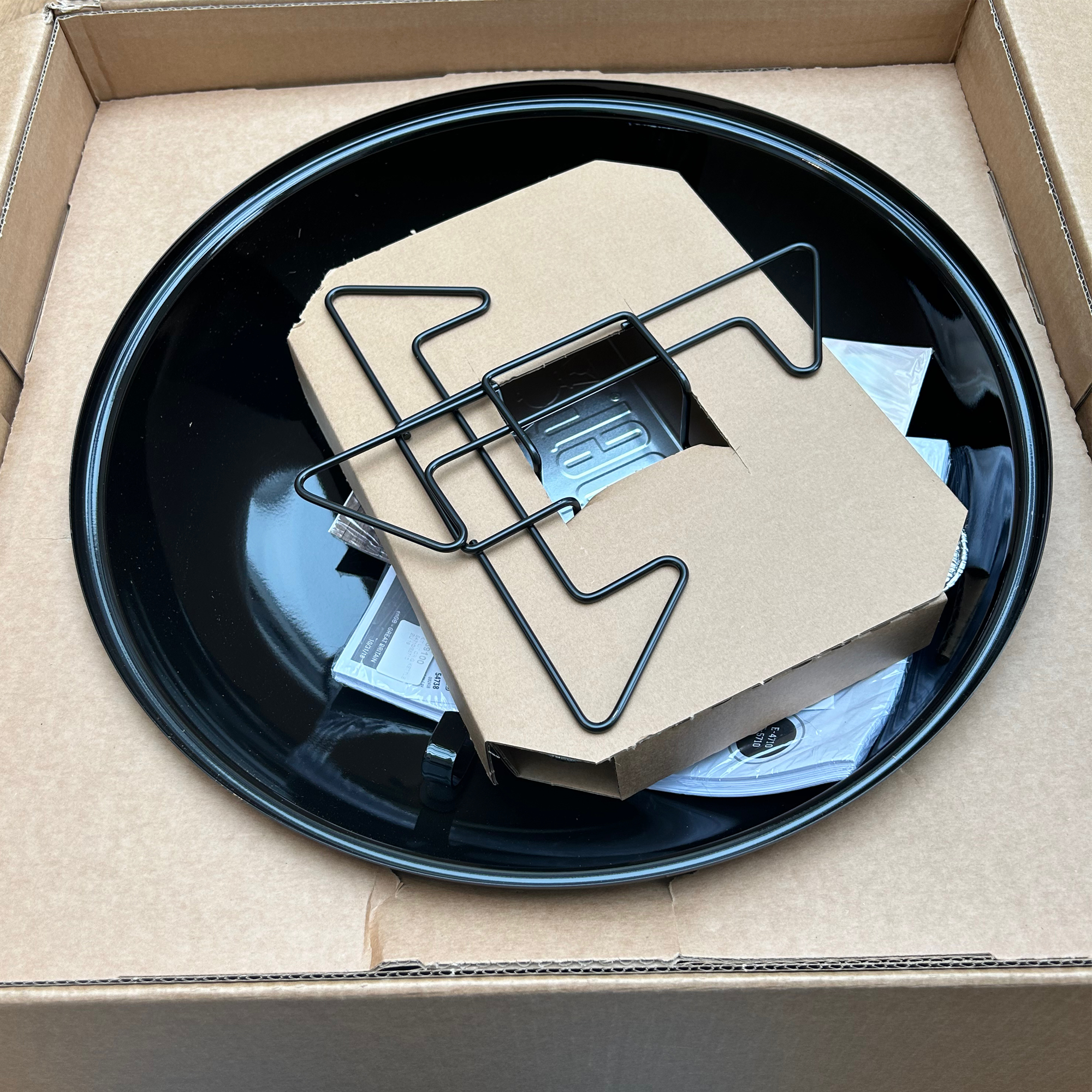
It’s a tripod barbecue with two wheels and a handle on the opposite side. I found it easy to pull around when it needed moving. My patio is split level though, so I kind of wished there was a second handle to make lifting it easier. But with that being said, it’s small enough that lifting wasn’t too much trouble.

The handle has two small hooks for your barbecue tools. A hook inside the lid means it can be hooked onto the side of the barbecue when not in use. Helpfully, it can be hooked on any side, so if you need to put it in a particular spot to deflect wind, you can. The cooking grid can also be hooked onto the side while you load it up with coals, which is great because it’s often mucky and greasy and it can be hard to know where to put it if you want to avoid greasy splodges on your patio.

Airflow plays an important role in controlling a charcoal barbecue and this is addressed with dampers and vents in both the base and the lid. Other great features include the thermometer in the lid and a heat shield that prevents the lid handle from getting too hot to touch.
Cooking on the Weber Original Kettle E4710
Firstly, let me just say that as with any charcoal barbecue, even super expensive ones like the Kamado Joe Classic Joe BBQ, the results you get depend a lot on the type and amount of charcoal you use, as well as how accomplished you are at barbecuing. But they don’t get much easier to use than this Weber Kettle.
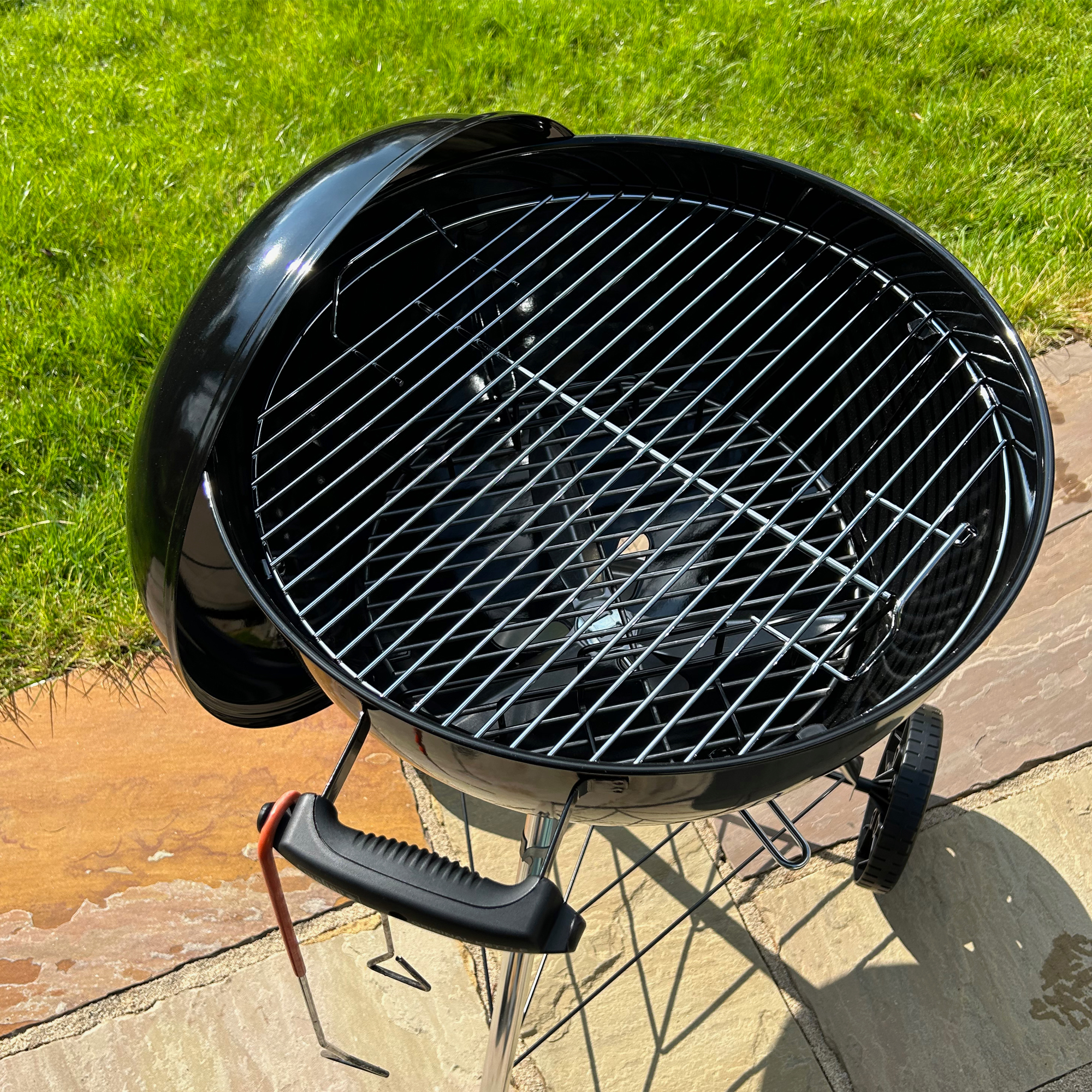
The first time I lit it, I used one of the instant light charcoal bags - the type where it comes in a brown paper bag and you light the bag. It worked okay but the pieces inside the bag were quite small and a lot fell through the grate. I later used briquettes as well as chunkier lumpwood charcoal and these worked much better, retaining heat for longer. You can buy charcoal directly from Weber which is probably going to be better quality than the stuff you grab from the local petrol station. And if you want to get serious about barbecuing, it’s worth getting decent fuel.

For my first go on this barbecue I made up seven mixed vegetable skewers and sliced two blocks of halloumi into chunky slices and loaded up the cooking grate. Initially the skewers took up the majority of the cooking space, but as they cooked and shrunk I was able to manoeuvre them to allow space for the halloumi.
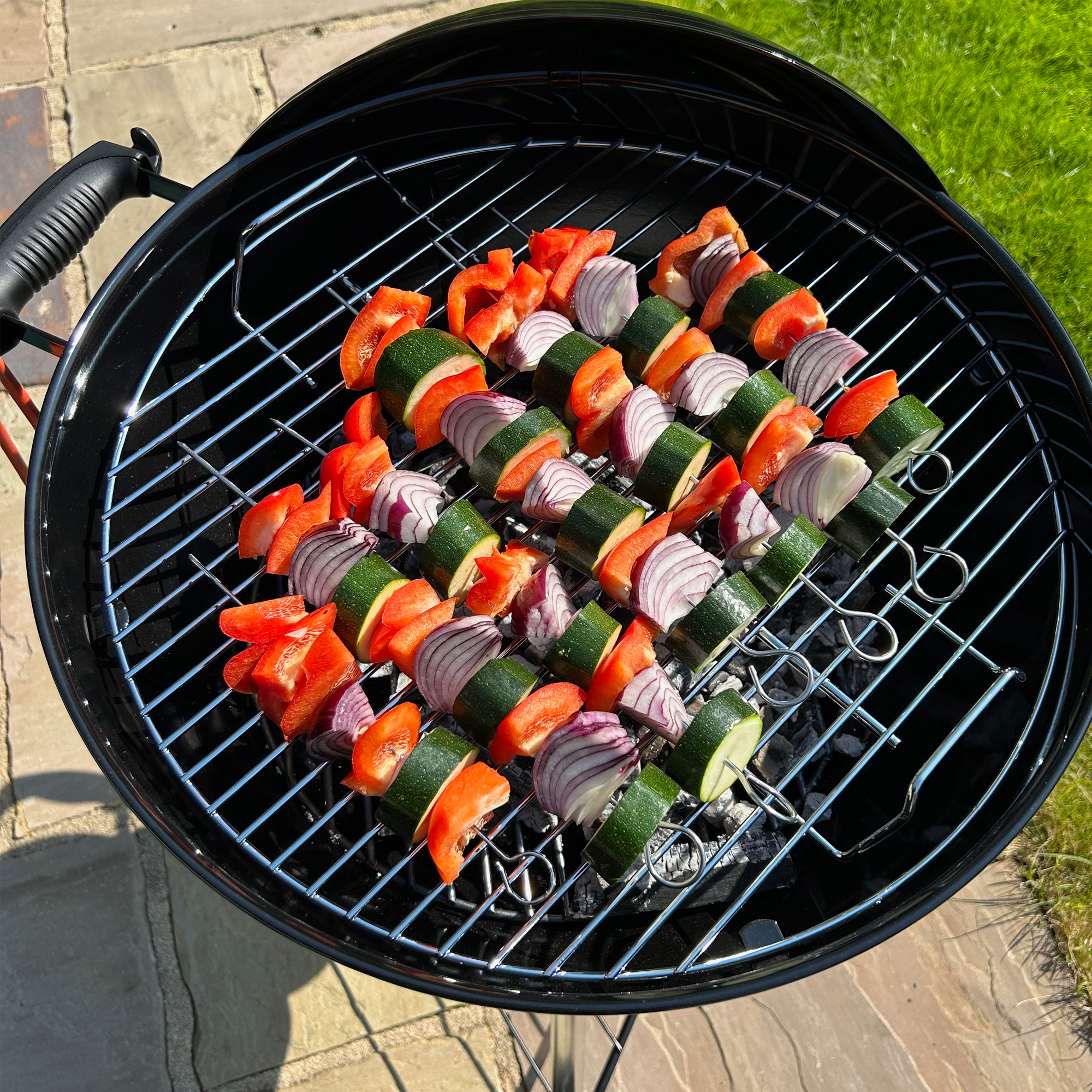
This particular day was sunny but quite blustery, and my pathetic instant light charcoal bag only just stayed hot enough to cook the skewers and halloumi. But the results were good nevertheless. I managed not to lose any halloumi through the cooking grate. Plus, I was able to play around with the damper on the lid to try and stop some of the blustery wind playing havoc with the temperature of the coals.
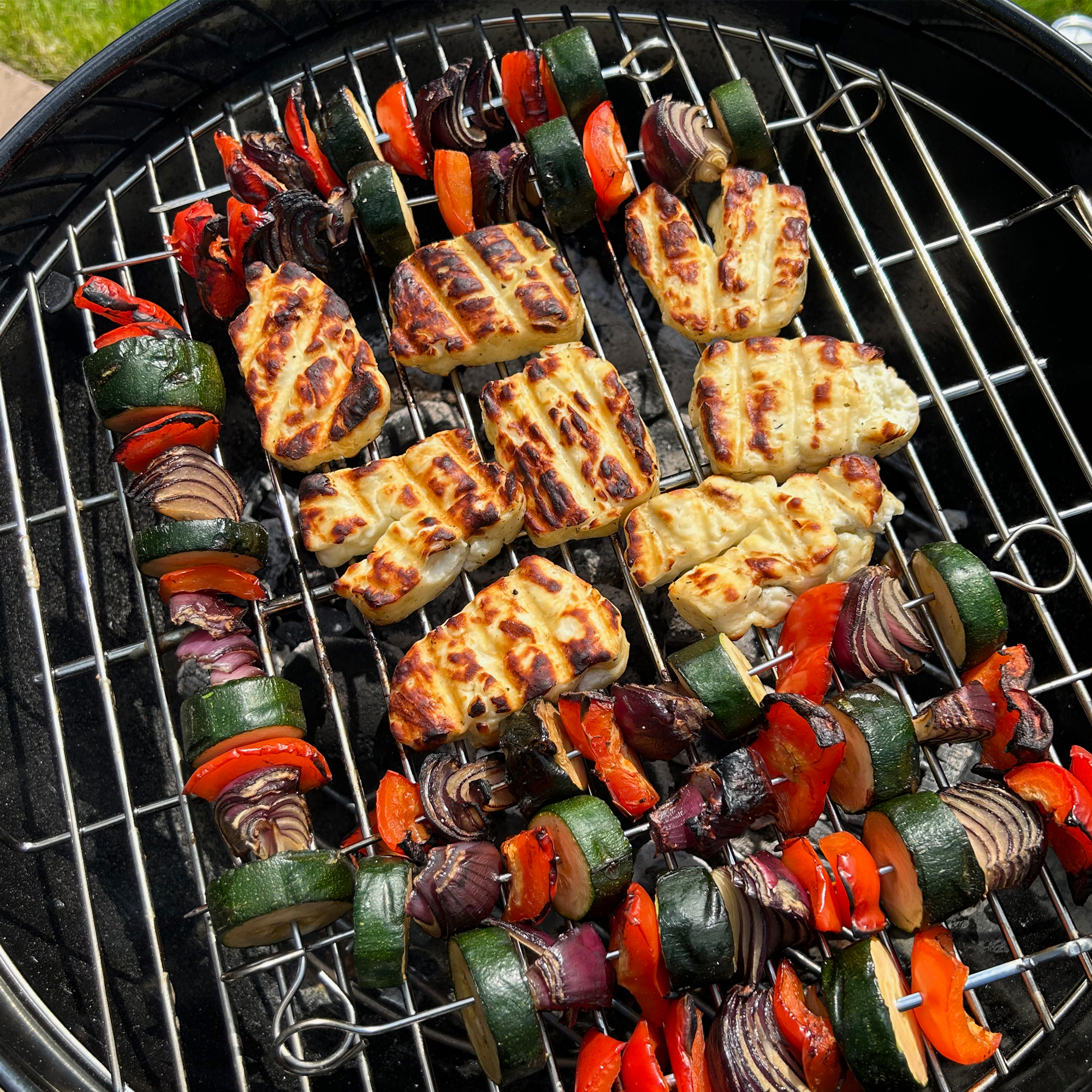
For my next meal I thought I’d try out the new trend of ‘corn ribs’. If you haven’t heard of it, it’s basically corn on the cob cut into quarters lengthways before cooking. Side note: the cutting part is hard work! But I persevered and cut up four cobs which gave me 16 corn ribs. Once the barbecue was hot, I added these along with spicy sausages to the grill plate. After they’d been cooking for a short time, I added asparagus that I had threaded onto a skewer so it didn’t fall through the grate.
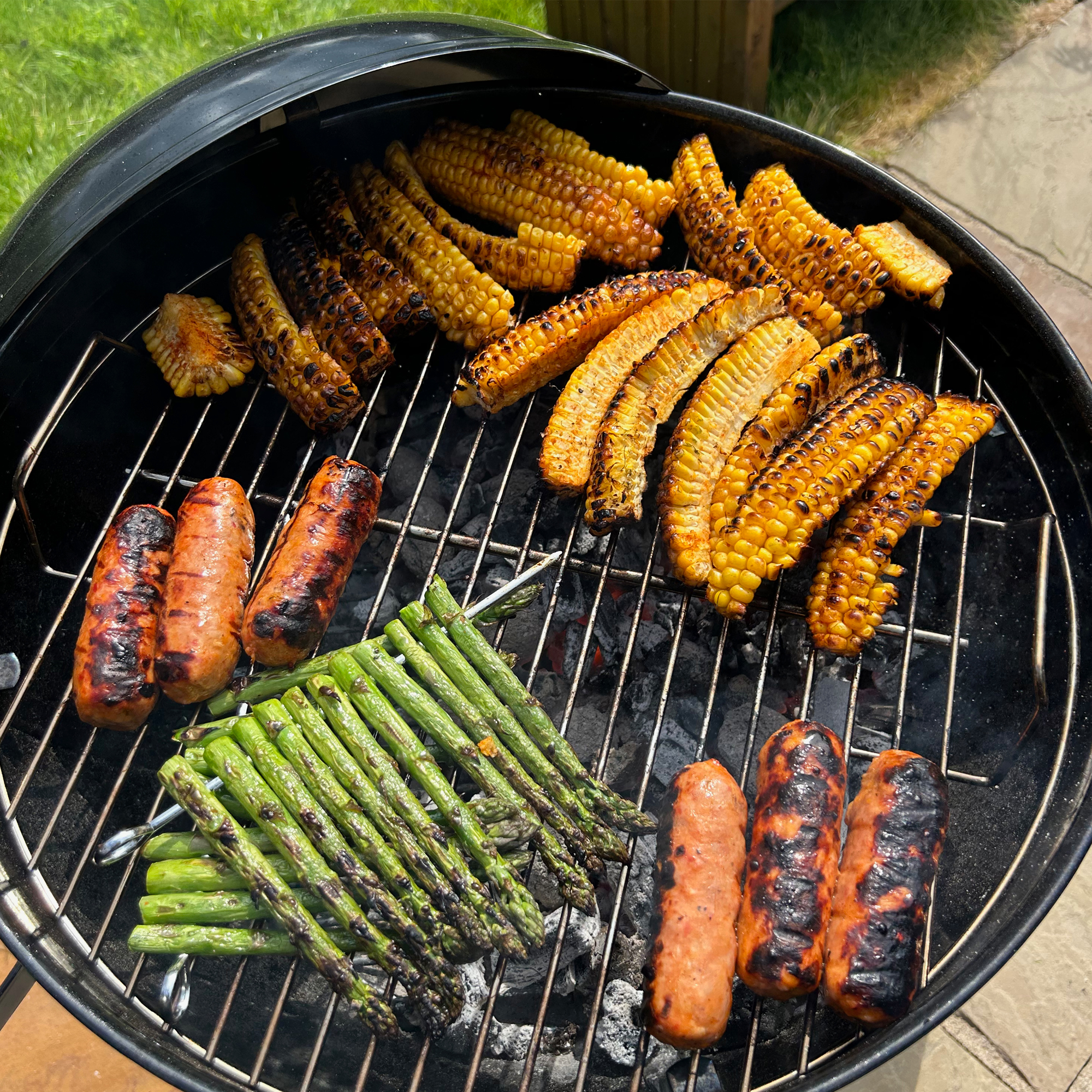
I was surprised that despite being considered a small barbecue, there was plenty of space for all this food. Cooking corn like this is a great idea because unlike cooking a whole corn on the cob, you don’t have to turn it a thousand times to make sure it cooks all the way around. But it took me by surprise how fast it cooked.
The sausages were nicely, but not overly, charred and caramelised, whilst being perfectly cooked in the centre. The asparagus also cooked well and I certainly noticed the difference it made using a combination of lumpwood and briquettes as opposed to the instant light bag.
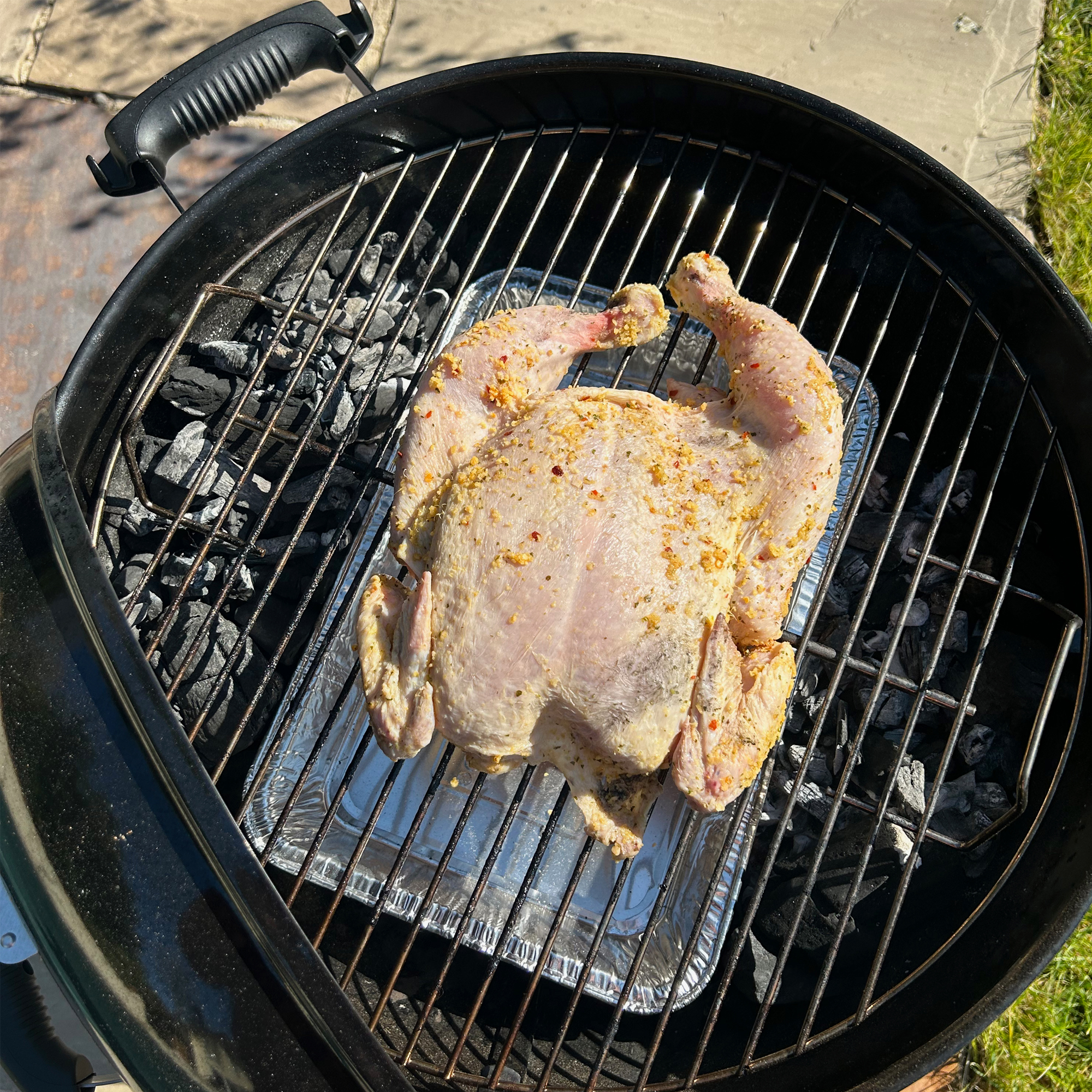
Finally, I cooked a spatchcock chicken, which is my preferred way of barbecuing a whole chicken. It’s easier and quicker to cook because it’s flatter. For this, I tried out the indirect heat cooking method that’s described in the user manual. I added the charcoal rails and made a pile of charcoal on either side of each rail. I then placed the foil drip tray in the middle and lit each of the charcoal piles.
Once the charcoal was all burning well and the temperature had settled, I added my spatchcock chicken to the cooking grate and closed the lid. The thermometer in the lid showed a very consistent temperature of around 210 - 220oC for the whole cook.
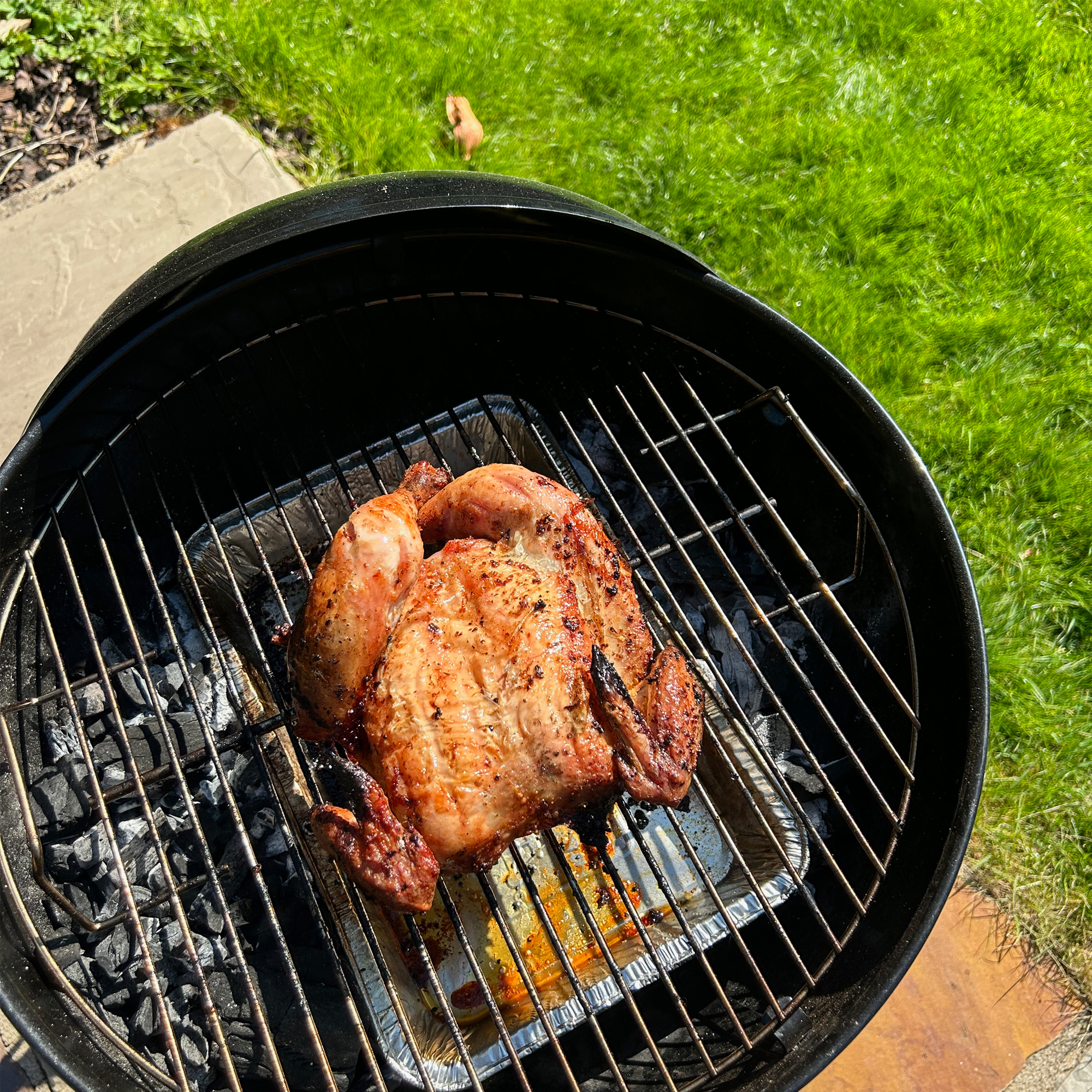
I really enjoyed this method of cooking, it’s quite hands off, which is ideal for those extra hot days where you want barbecue food, but even the thought of standing over a barbecue makes you sweat. I left the lid on the whole time and turned the chicken after 20 minutes, then again after 40 and 50 minutes.
It was cooked in an hour, with impressively moist, juicy meat and crisp skin, but most importantly, no burnt bits - hurrah! I also noticed that even after an hour of cooking, the lid handle stayed cool enough to hold comfortably.
Cleaning and maintenance
Cleaning out a charcoal barbecue is pretty much always going to be a messy job. The one-touch cleaning system does make it somewhat easier though. Moving the exterior handle from right to left pushes any ash in the base of the bowl out into the ash catcher bowl below. Then the bowl can be lifted and the ash tipped into the bin.
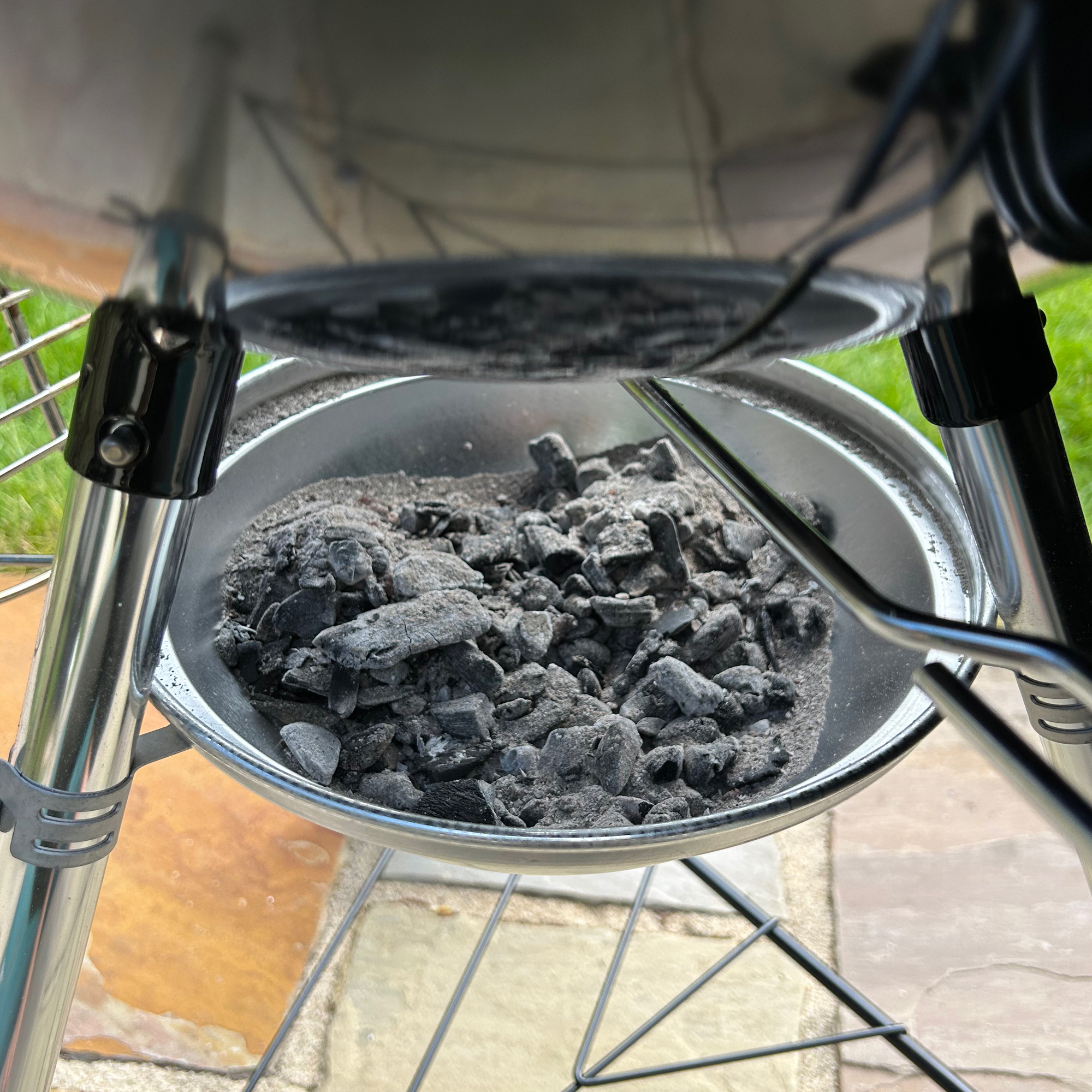
The cooking grate shouldn’t need much cleaning. If it’s preheated over very hot charcoal before use, you can use a barbecue cleaning brush to brush off any residue before cooking on it. Personally I don’t tend to clean charcoal barbecues much more than that. Weber sells the brushes as well as barbecue cleaning kits.
How does it compare to similar models and other Weber BBQs?
If you’re looking for a compact barbecue but think charcoal might not be your thing, I’d recommend checking out the Cadac Citi Chef 40 FS. This gas barbecue is an easy-to-use barbecue that will suit those new to gas barbecues. It’s a similar size to the Weber Original Kettle and slightly cheaper. There are plenty of optional accessories available to make it multi-purpose and it looks very stylish on your patio.
Alternatively, if you want a more compact and portable barbecue, take a look at the Weber Go Anywhere barbecue. It’s perfect for camping trips, but equally, it’s a great option if you generally only barbecue for two people. It’s affordable and easy to store, but it’s reassuringly sturdy and designed with Weber’s barbecue expertise.
Should you buy the Weber Original Kettle E4710?
The Weber Original Kettle is a great buy. It’ll suit just about anyone looking for a good quality charcoal barbecue from a brand with an excellent pedigree. Admittedly the E4710 might be a little small for some households, but in that case, you could upgrade to the E5710 which is essentially the same model but with a bigger 57cm diameter cooking grid.
The Original Kettle is a practical choice that’ll please newbies as well as long standing fans of charcoal barbecues. I don’t think you can go wrong with Weber, and a kettle barbecue allows you to hone your skills without being intimidating.
About this review, and the reviewer
As part of our commitment to how we test products we recommend at Ideal Home, Helen tried out this barbecue in April and obsessively checked the weather forecast so that she could use it on some of the few sunny days during spring in the UK. She was allowed to keep the barbecue after the review.







